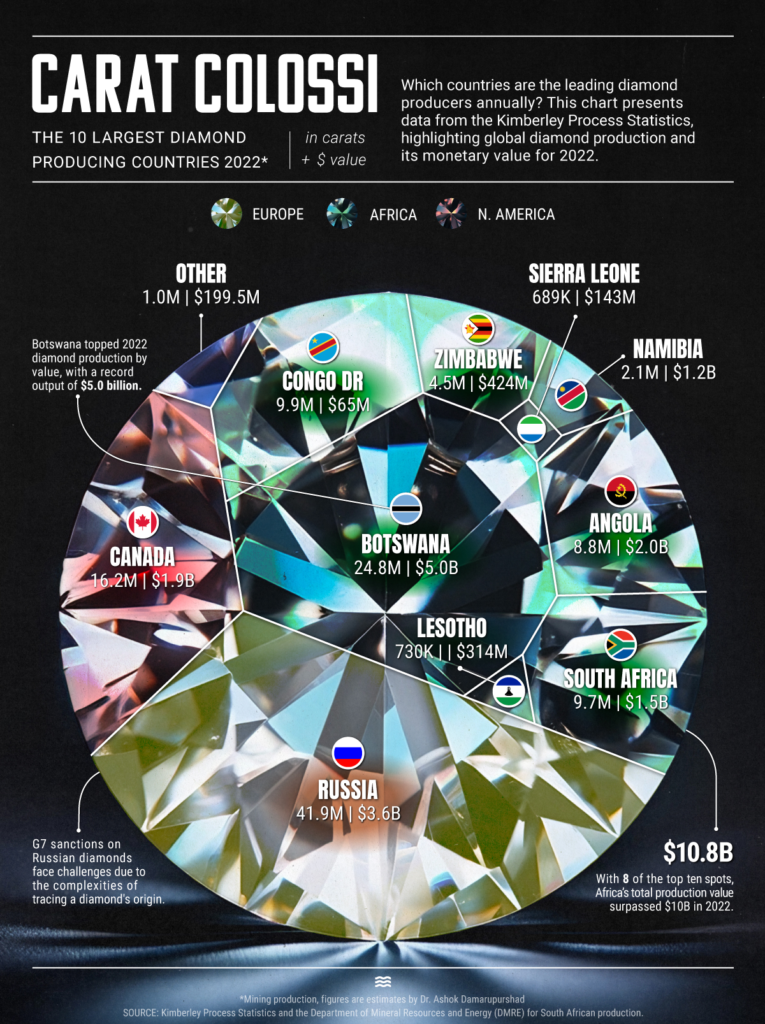Ranked: The world’s top diamond mining countries, by carats and value

Only 22 countries in the world engage in rough diamond production—also known as uncut, raw or natural diamonds—mining for them from deposits within their territories.
This chart, by Sam Parker illustrates the leaders in rough diamond production by weight and value. It uses data from Kimberly Process (an international certification organization) along with estimates by Dr. Ashok Damarupurshad, a precious metals and diamond specialist in South Africa.
Rough diamond production, by weight
Russia takes the top spot as the world’s largest rough diamond producer, mining close to 42 million carats in 2022, well ahead of its peers.
Russia’s large lead over second-place Botswana (24.8 million carats) and third-ranked Canada (16.2 million carats) indicates that the country’s diamond production is circumventing sanctions due to the difficulties in tracing a diamond’s origin.
As with most other resources, (oil, gold, uranium), rough diamond production is distributed unequally. The top 10 rough diamond producing countries by weight account for 99.2% of all rough diamonds mined in 2022.
Diamond mining, by country
However, higher carat mined doesn’t necessarily mean better value for the diamond. Other factors like the cut, color, and clarity also influence a diamond’s value.
Thus, even though Botswana only produced 59% of Russia’s diamond weight in 2022, it had a trade value of nearly $5 billion, approximately 1.5 times higher than Russia’s for the same year.
Another example is Angola, which is ranked 6th in diamond production, but 3rd in diamond value.
Both countries (as well as South Africa, Canada, and Namibia) produce gem-quality rough diamonds versus countries like Russia and the DRC whose diamonds are produced mainly for industrial use.
Which regions produce the most diamonds in 2022?
Unsurprisingly, Africa is the largest rough diamond producing region, accounting for 51% of output by weight, and 66% by value.
However diamond mining in Africa is a relatively recent phenomenon, fewer than 200 years old. Diamonds had been discovered—and prized—as far back as 2,000 years ago in India, later on spreading west to Egyptian pharaohs and the Roman Empire.
By the start of the 20th century, diamond production on a large scale took off: first in South Africa, and decades later in other African countries. In fact between 1889–1959, Africa produced 98% of the world’s diamonds.
And in the latter half of the 20th century, the term blood diamond evolved from diamonds mined in African conflict zones used to finance insurgency or crime.
(This article first appeared in the Visual Capitalist)
More News
{{ commodity.name }}
{{ post.title }}
{{ post.date }}

2 Comments
Patrick Ketlogetswe Ketlogetswe
I would like to have my own farm as an interprenuener..
Christina Dian Parmionova
Higher carat mined doesn’t necessarily mean better value for the diamond. Other factors like the cut, color, and clarity also influence the value of the stone.